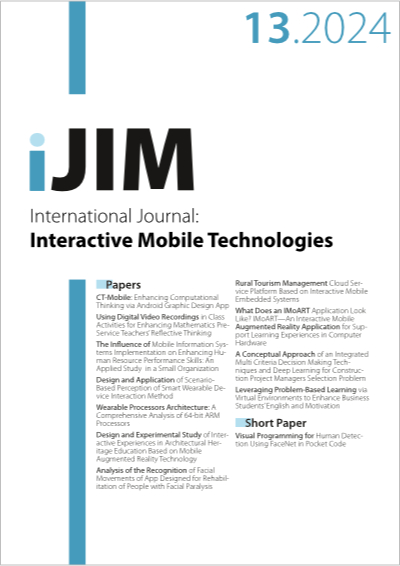Analysis of the Recognition of Facial Movements of App Designed for Rehabilitation of People with Facial Paralysis
DOI:
https://doi.org/10.3991/ijim.v18i13.45293Keywords:
Augmented Reality, Peripheral Facial Paralysis, Motor RehabilitationAbstract
Peripheral facial paralysis (PFP) causes deficits in muscle and sensory functions of the face due to damage to the facial nerve. In this study, we evaluated the effectiveness of the “Fisiobem” app in rehabilitating patients with PFP through facial mimicry exercises. The app uses the device’s camera to identify the user and measure the range of motion during the exercises, applying the ARKit framework to quantify the intensity of the movements. We conducted a usability study with 34 participants unaffected by PFP, performing mimics with different amplitudes. Results show that glasses did not affect recognition accuracy in exercises such as raising eyebrows, frowning, and closing the eyes tightly. As for wrinkling the nose exercise, glasses impacted higher intensities. As for the beard or mustache, lower lip protrusion, compressing the lips, smiling, showing teeth and blowing out filling cheeks were not affected. However, when smiling with lips together, beard and mustache influenced intensities above 75%. It is important to highlight that this study has limitations, such as the sample size and lack of consideration for ethnic diversity among participants. Future research with larger and more diverse samples is needed to validate and generalize these findings and explore the nuances of interactions between facial features and facial recognition algorithms. Despite these limitations, the approach facilitated by the “Fisiobem” application offers significant benefits, especially for patients with PFP who face challenges in accessing specialized therapists. It allows patients to complement their treatment by performing guided facial mimicry exercises at home. The application helps individuals accurately perform the exercises and effectively track the progress of their rehabilitation.
Downloads
Published
How to Cite
Issue
Section
License
Copyright (c) 2024 Ana Grasielle Dionisio Correa, Anna de Souza Cruz Ravaglio, Flávio Hergersheimer Navikas, Jucelio Delmondes do Amaral, Paulo César Machado Filho, Matheus Gois de Lima Silva, Daniela Vieira Cunha, Bruno da Silva Rodrigues

This work is licensed under a Creative Commons Attribution 4.0 International License.



